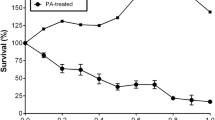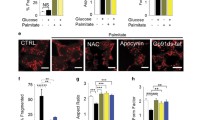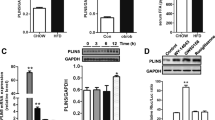Abstract
Objective
While the reduction of transient receptor potential channel subfamily M member 5 (TRPM5) has been reported in islet cells from type 2 diabetic (T2D) mouse models, its role in lipotoxicity-induced pancreatic β-cell dysfunction remains unclear. This study aims to study its role.
Methods
Pancreas slices were prepared from mice subjected to a high-fat-diet (HFD) at different time points, and TRPM5 expression in the pancreatic β cells was examined using immunofluorescence staining. Glucose-stimulated insulin secretion (GSIS) defects caused by lipotoxicity were mimicked by saturated fatty acid palmitate (Palm). Primary mouse islets and mouse insulinoma MIN6 cells were treated with Palm, and the TRPM5 expression was detected using qRT-PCR and Western blotting. Palm-induced GSIS defects were measured following siRNA-based Trpm5 knockdown. The detrimental effects of Palm on primary mouse islets were also assessed after overexpressing Trpm5 via an adenovirus-derived Trpm5 (Ad-Trpm5).
Results
HFD feeding decreased the mRNA levels and protein expression of TRPM5 in mouse pancreatic islets. Palm reduced TRPM5 protein expression in a time- and dose-dependent manner in MIN6 cells. Palm also inhibited TRPM5 expression in primary mouse islets. Knockdown of Trpm5 inhibited insulin secretion upon high glucose stimulation but had little effect on insulin biosynthesis. Overexpression of Trpm5 reversed Palm-induced GSIS defects and the production of functional maturation molecules unique to β cells.
Conclusion
Our findings suggest that lipotoxicity inhibits TRPM5 expression in pancreatic β cells both in vivo and in vitro and, in turn, drives β-cell dysfunction.
Similar content being viewed by others
References
Shimabukuro M, Zhou YT, LeviShimabukuro M, et al. Fatty acid-induced beta cell apoptosis: a link between obesity and diabetes. Proc Natl Acad Sci U S A, 1998,95(5):2498–2502
Thompson B, Satin LS. Beta-Cell Ion Channels and Their Role in Regulating Insulin Secretion. Compr Physiol, 2021,11(4):1–21
Chen CG, Chmelova H, Cohrs CM, et al. Alterations in β-Cell Calcium Dynamics and Efficacy Outweigh Islet Mass Adaptation in Compensation of Insulin Resistance and Prediabetes Onset. Diabetes, 2016,65(9):2676–2685
Yan ZH, Shyr ZA, Fortunato M, et al. High-fat-diet-induced remission of diabetes in a subset of K(ATP)-GOF insulin-secretory-deficient mice. Diabetes Obes Metab, 2018,20(11):2574–2584
Pyrski M, Eckstein E, Schmid A, et al. Trpm5 expression in the olfactory epithelium. Mol Cell Neurosci, 2017,80:75–88
Dutta Banik D, Martin LE, Freichel M, et al. TRPM4 and TRPM5 are both required for normal signaling in taste receptor cells. Proc Natl Acad Sci U S A, 2018,115(4):E772–E781
Ascencio Gutierrez V, Simental Ramos A, Khayoyan S, et al. Dietary experience with glucose and fructose fosters heightened avidity for glucose-containing sugars independent of TRPM5 taste transduction in mice. Nutr Neurosci, 2022:1–12
Colsoul B, Schraenen A, Lemaire K, et al. Loss of high-frequency glucose-induced Ca2+ oscillations in pancreatic islets correlates with impaired glucose tolerance in Trpm5-/- mice. Proc Natl Acad Sci USA, 2010,107(11):5208–5213
Brixel LR, Monteilh-Zoller MK, Ingenbrandt CS, et al. TRPM5 regulates glucose-stimulated insulin secretion. Pflugers Arch, 2010,460(1):69–76
Colsoul B, Jacobs G, Philippaert K, et al. Insulin downregulates the expression of the Ca2+-activated nonselective cation channel TRPM5 in pancreatic islets from leptin-deficient mouse models. Pflugers Arch, 2014,466(3):611–621
Sun Y, Zhou Y, Shi Y, et al. Expression of miRNA-29 in Pancreatic β Cells Promotes Inflammation and Diabetes via TRAF3. Cell Rep, 2021,34(1):108576
Sun Y, Zhou S, Shi Y, et al. Inhibition of miR-153, an IL-1β-responsive miRNA, prevents beta cell failure and inflammation-associated diabetes. Metabolism, 2020,111:154335
Zhu Y, Sun Y, Zhou Y, et al. MicroRNA-24 promotes pancreatic beta cells toward dedifferentiation to avoid endoplasmic reticulum stress-induced apoptosis. J Mol Cell Biol, 2019,11(9):747–760
Meng ZX, Nie J, Ling JJ, et al. Activation of liver X receptors inhibits pancreatic islet beta cell proliferation through cell cycle arrest. Diabetologia, 2009,52(1):125–135
Li Y, Jing C, Tang X, Chen Y, et al. LXR activation causes G1/S arrest through inhibiting SKP2 expression in MIN6 pancreatic beta cells. Endocrine, 2016,53(3):689–700
Oh YS, Bae GD, Baek DJ, et al. Fatty Acid-Induced Lipotoxicity in Pancreatic Beta-Cells During Development of Type 2 Diabetes. Front Endocrinol (Lausanne), 2018,9:384
Carpentier AC, Bourbonnais A, Frisch F, et al. Plasma nonesterified fatty acid intolerance and hyperglycemia are associated with intravenous lipid-induced impairment of insulin sensitivity and disposition index. J Clin Endocrinol Metab, 2010,95(3):1256–1264
Briaud I, Kelpe CL, Johnson LM, et al. Differential effects of hyperlipidemia on insulin secretion in islets of langerhans from hyperglycemic versus normoglycemic rats. Diabetes, 2002,51(3):662–668
Laybutt DR, Preston AM, Akerfeldt MC, et al. Endoplasmic reticulum stress contributes to beta cell apoptosis in type 2 diabetes. Diabetologia, 2007,50(4):752–763
Lee JH, Lee J. Endoplasmic Reticulum (ER) Stress and Its Role in Pancreatic β-Cell Dysfunction and Senescence in Type 2 Diabetes. Int J Mol Sci, 2022,23(9):4843
Basha B, Samuel SM, Triggle CR, et al. Endothelial dysfunction in diabetes mellitus: possible involvement of endoplasmic reticulum stress? Exp Diabetes Res, 2012,2012:481840
Song B, Scheuner D, Ron D, et al. Chop deletion reduces oxidative stress, improves beta cell function, and promotes cell survival in multiple mouse models of diabetes. J Clin Invest, 2008,118(10):3378–3389
Tumova J, Andel M, Trnka J. Excess of free fatty acids as a cause of metabolic dysfunction in skeletal muscle. Physiol Res, 2016,65(2):193–207
Lei X, Zhang S, Emani B, et al. A link between endoplasmic reticulum stress-induced β-cell apoptosis and the group VIA Ca2+-independent phospholipase A2 (iPLA2β). Diabetes Obes Metab, 2010,Suppl 2(02):93–98
Borg J, Klint C, Wierup N, et al. Perilipin is present in islets of Langerhans and protects against lipotoxicity when overexpressed in the beta-cell line INS-1. Endocrinology, 2009,150(7):3049–305
Hara T, Mahadevan J, Kanekura K, et al. Calcium efflux from the endoplasmic reticulum leads to β-cell death. Endocrinology, 2014,155(3):758–768
Kang S, Dahl R, Hsieh W, et al. Small Molecular Allosteric Activator of the Sarco/Endoplasmic Reticulum Ca2+-ATPase (SERCA) Attenuates Diabetes and Metabolic Disorders. J Biol Chem, 2016,291(10):5185–5198
Sakaguchi T, Okumura R, Ono C, et al. TRPM5 Negatively Regulates Calcium-Dependent Responses in Lipopolysaccharide-Stimulated B Lymphocytes. Cell Rep, 2020,31(10):107755
Liu D, Liman ER. Intracellular Ca2+ and the phospholipid PIP2 regulate the taste transduction ion channel TRPM5. Proc Natl Acad Sci U S A, 2003,100(25):15160–15165
Wyatt A, Wartenberg P, Candlish M, et al. Genetic strategies to analyze primary TRP channel-expressing cells in mice. Cell Calcium, 2017,67:91–104
Young RL, Sutherland K, Pezos N, et al. Expression of taste molecules in the upper gastrointestinal tract in humans with and without type 2 diabetes. Gut, 2009,58(3):337–346
Vennekens R, Mesuere M, Philippaert K. Mesuere and K. Philippaert, TRPM5 in the battle against diabetes and obesity. Acta Physiol (Oxf), 2018,222(2)
Ketterer C, Müssig K, Heni M, et al. Genetic variation within the TRPM5 locus associates with prediabetic phenotypes in subjects at increased risk for type 2 diabetes. Metabolism, 2011,60(9):1325–1333
Philippaert K, Pironet A, Mesuere M, et al. Steviol glycosides enhance pancreatic beta-cell function and taste sensation by potentiation of TRPM5 channel activity. Nat Commun, 2017,8:14733
Huang YA, Roper SD. Intracellular Ca(2+) and TRPM5-mediated membrane depolarization produce ATP secretion from taste receptor cells. J Physiol, 2010,588(3):2343–2350
Damak S, Rong M, Yasumatsu K, et al. Trpm5 null mice respond to bitter, sweet, and umami compounds. Chem Senses, 2006,31(3):253–264
Talavera K, Yasumatsu K, Voets T, et al. Heat activation of TRPM5 underlies thermal sensitivity of sweet taste. Nature, 2005,438(7070):1022–1025
Servant G, Tachdjian C, Tang XQ, et al. Positive allosteric modulators of the human sweet taste receptor enhance sweet taste. Proc Natl Acad Sci U S A, 2010,107(10):4746–4751
Liman ER. A TRP channel contributes to insulin secretion by pancreatic beta-cells. Islets, 2010,2(5):331–333
Shigeto M, Ramracheya R, Tarasov AI, et al. GLP-1 stimulates insulin secretion by PKC-dependent TRPM4 and TRPM5 activation. J Clin Invest, 2015,125(12):4714–4728
Kyriazis GA, Soundarapandian MM, Tyrberg B. Sweet taste receptor signaling in beta cells mediates fructose-induced potentiation of glucose-stimulated insulin secretion. Proc Natl Acad Sci U S A, 2012,109(8):524–532
Prawitt D, Monteilh-Zoller MK, Brixel L, et al. TRPM5 is a transient Ca2+-activated cation channel responding to rapid changes in [Ca2+]i. Proc Natl Acad Sci U S A, 2003,100(25):15166–15171
Yu Q, Gamayun I, Wartenberg P, et al. Bitter taste cells in the ventricular walls of the murine brain regulate glucose homeostasis. Nat Commun, 2023,14(1):1588
Author information
Authors and Affiliations
Corresponding authors
Ethics declarations
The authors declare that there is no conflict of interest with any financial organization or corporation or individual that can inappropriately influence this work.
Author Xiao HAN is a member of the Editorial Board for Current Medical Science. The paper was handled by the other editors and has undergone rigorous peer review process. Author Xiao HAN was not involved in the journal’s review of, or decisions related to, this manuscript.
Additional information
This study was supported by grants from the National Natural Science Foundation of China (No. 81830024, No. 82270844 and No. 82070843).
Rights and permissions
About this article
Cite this article
Wang, Ky., Wu, Sm., Yao, Zj. et al. Insufficient TRPM5 Mediates Lipotoxicity-induced Pancreatic β-cell Dysfunction. CURR MED SCI 44, 346–354 (2024). https://doi.org/10.1007/s11596-023-2795-5
Received:
Accepted:
Published:
Issue Date:
DOI: https://doi.org/10.1007/s11596-023-2795-5




